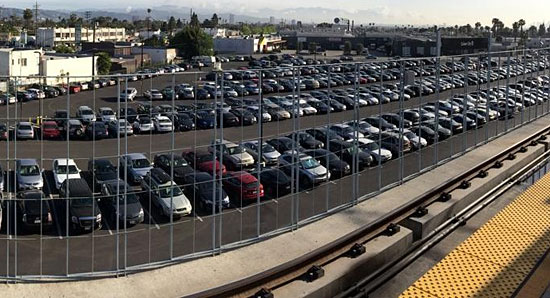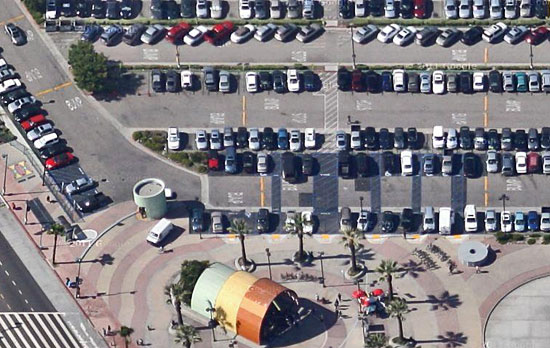Metro’s park ‘n’ gripe problem
June 25, 2014
Angelenos cite lots of reasons for sticking with their cars rather than taking public transportation, but here’s one excuse that even Metro acknowledges can be valid:
Not being able to find a parking space at the station.
A new report by the transit agency found a dramatic parking space shortfall at the two Red Line subway stations in the San Fernando Valley, where customer demand is more than triple the supply. That means that thousands of commuters looking to ride the subway to Hollywood and downtown L.A. may be forced to stick with the congested freeways instead.
“If I’m already in my car and the lot is full, I don’t have any choice—I stay in my car and drive,” says Calvin Hollis, Metro’s planning manager in charge of parking. “I think that’s what’s happening.”
Overall, parking capacity at Metro’s rail stations and its Orange Line rapid transit busway is a mixed bag, the report found. The 11 busiest lots include the two at Red Line stations in the Valley, five on the Gold Line and three on the Blue Line—all of which are operating at 85% capacity or greater. At the other end of the spectrum are facilities like the lot at the Orange Line’s Sepulveda station, which is operating at only 8% of capacity.
The report measured “unconstrained demand,” transportation parlance for the number of cars that would park if there was unlimited space and no restrictions, as determined by a complex formula including socioeconomic data and passenger surveys.
At the North Hollywood station, those numbers add up to a whole lot of aggravation for drivers who might prefer to transfer to the subway, with unconstrained demand of 3,014 vehicles on an average weekday but only 951 available spots. The mathematics of parking also are bad at Universal City, where the demand is for 2,124 spaces per weekday with just 565 spots available, plus 281 more at adjacent county and state-owned lots.
There are plans to add 500 spaces in North Hollywood over the next two years, but that still won’t come close to meeting the demand. At Universal City, a lack of Metro-owned property means that few easy options are available in the short term. Existing lots can be reconfigured to squeeze in a few more slots, but that’s about it.
Hollis says Metro’s Board of Directors needs to decide whether to take more aggressive steps, which could include building parking structures or acquiring more land. Another option is working with private developers on projects that provide transit parking in addition to residential and commercial spaces. One such agreement was struck in 2007, but the real estate crash of 2008 forced the developer to back out. Now that the market has bounced back, Hollis says, Metro is preparing to revisit the option of joint development by issuing a new request for proposals.
The parking capacity report comes in response to a December motion by L.A. City Councilmember Paul Krekorian, Supervisor Zev Yaroslavsky and Mayor Eric Garcetti. The motion directed the agency to look at the frustrating situation at the Red Line stations, which serve as a transit gateway to Hollywood and downtown L.A for millions who live in the San Fernando Valley and places further north.
Metro also is reviewing the dynamics of parking throughout its entire rail system, which is expanding to more communities with projects like Expo Line Phase 2, the Gold Line Foothill Extension and Crenshaw/LAX. The first phase of the Expo Line, which extends from downtown L.A. to Culver City, is already feeling the crunch.
“The Culver City lot is at capacity, so I think we are going to have the same situation that we have at North Hollywood,” Hollis says.
Aside from availability, the agency also may need to revisit its policy on selling reserved spaces at busy lots, Hollis says. While the practice generates some revenue that can be used to build more spaces, it also decreases the number of cars that can park during rush hour. “We are reserving spaces that don’t get used during the peak time and they sit there empty,” Hollis says.
Hollis will present his findings to the agency’s Board of Directors in July. He’s also recruiting Metro’s first director of parking—someone with substantial experience managing large systems.
Metro currently has more than 10,000 spaces, but now is in the process of acquiring 42 state-owned lots with a total of 12,000 spaces. (None of which, unfortunately, will be going toward alleviating the shortage at the two Valley subway stations.) Additional new spaces will be coming into the system as Metro’s rail network expands in the years to come. It all adds up to a lot of territory, and issues, for a new parking czar to oversee.
“We have to realize we are in the parking business,” Hollis says. “We’re going to have about 30,000 parking spaces. It’s time to get serious about it.”

It's also tough to find a parking space at the Expo Line's Culver City station. Photo/Streetsblog LA
Posted 6/25/14













 405 bridge work causes a stink
405 bridge work causes a stink

